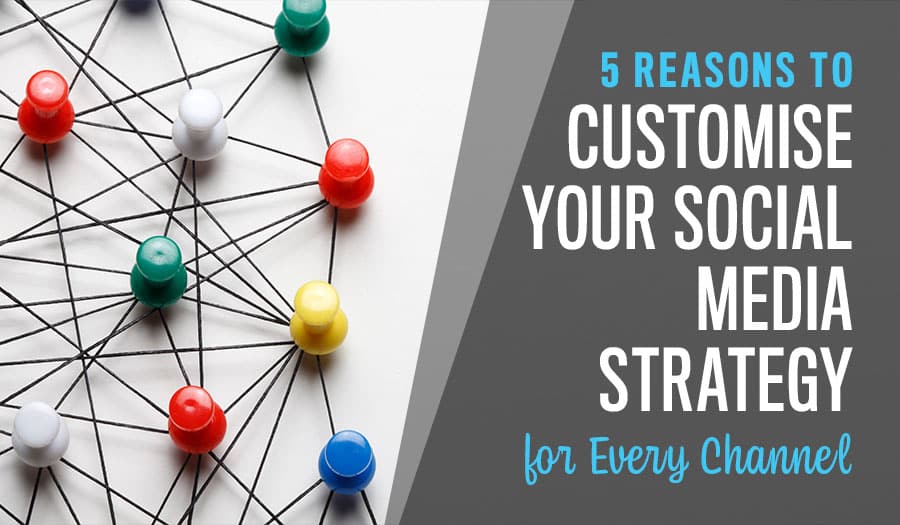Digital marketing, and social media, in particular, are complex. You’re talking about a wide range of channels requiring different approaches and engagement tactics. Simply posting the same content across platforms is not enough. Instead, you need to build a unique strategy for each platform you want to leverage. Let’s explore 5 Reasons to Customise Your Social Media Strategy for Every Channel.
In the age of personalisation, no digital one-size-fits-all approach can work. Audiences who feel that brand messaging speaks directly to their need at a given time become significantly more likely to engage, buy, and retain your company.
At the same time, social media channels like Facebook and Snapchat have grown radically away from each other. What works on one channel is far from guaranteed on the next; the likelihood of failure is dangerously high. That, among other reasons, is precisely why you need to create a unique strategy for every social media platform you plan to use.
Heads-up: this is a post focused on social media, but you will actually feel the impact of every choice you make there on your website. A large chunk of your web traffic comes from these channels, and a successful social media marketing strategy can impact your SEO.
5 Reasons to Customise Your Social Media Strategy for Every Channel
- Different Audience Expectations
- Unique Network Advantages
- Different Algorithms and Channel-Specific Trends
- Varying Levels of Connections to Your Website
- The Benefits of a Diversified, Integrated Strategy
1. Different Audience Expectations
Everything in marketing should revolve around your audience, so let’s begin the argument here. As you might suspect, audience demographics on Facebook, Twitter, LinkedIn, and all the other popular social channels differ considerably in more ways than one:
- LinkedIn users are highly educated professionals, while Snapchat users tend to be too young for a degree.
- Twitter users look for news updates, while Facebook users want to interact with friends and family.
- Instagram users love the medium’s visual nature, while LinkedIn users prefer more text-based alternatives.
All of these, of course, are generalisations on some level. But they’re backed up by hard data and research that shows the deep distinction between each network’s average user base. While we won’t get into too much detail on those demographics, it’s important to understand how they impact unique expectations for each channel.
Visual users expect visuals. News-oriented users probably aren’t interested in the warm and fuzzies of nostalgia posts, but an audience talking to their family and friends will eat that up. The user base of the individual platform you’re trying to optimise, in other words, should play a major role in building a strategy specifically designed to succeed in that medium. You may also want to read our review of Twitter Vs Facebook Vs Instagram Vs LinkedIn.
2. Unique Network Advantages
Putting the audience aside, the networks offer a range of unique advantages that allow you to leverage them in various ways. Some of them are quite similar, but you can find differences even in these similarities. Others are specifically designed to be unique and need a unique playbook to unlock them.
Take Instagram as an example. The network’s main posts are largely visual, so you need a strategy to continually capture images (and videos) designed to appeal to your users. If you don’t, you either post sub-par images after a few weeks or no images at all.
Meanwhile, Instagram’s Stories feature is a more interactive tool that allows brands to showcase multi-component pieces designed to keep the audience’s attention. Twitter or LinkedIn don’t have a feature even close to that. Any Instagram strategy needs to include ideas on how to leverage Instagram Stories, but those other networks probably won’t need anything even approaching that strategy.
These unique network advantages often underlie the audience expectations discussed above. Any successful social media game plan has to begin with understanding the unique aspects of each channel you’re looking to engage with and ideas on how to take advantage of these specific channels. That alone makes building a solve-all social media strategy close to impossible.
3. Different Algorithms and Channel-Specific Trends
Every social media network uniquely handles its newsfeed. They all build towards relevance, but how they get there tends to be unique.
This guide can help you decode both the basic purpose of every social media algorithm and their underlying differences in more detail. We won’t go into that much depth; for this post, the most important thing to know is precisely how the differences in the algorithm should impact your strategy.
- Facebook is all about engagement. The more your users like your posts, watch your videos and comment on your pictures, the better. It also prefers native content, so links to your website should only be used strategically.
- Twitter is more real-time than Facebook. Users still have the option to see a simple reverse-chronological newsfeed, but even those that don’t see posts first that received engagement right after they were first published. Immediacy is king on this platform.
- LinkedIn expands audiences beyond direct followers and connections. A post that receives significant engagement actually opens up to second and third-degree connections, broadening its reach significantly. For this network, engagement and credibility are interchangeable.
- Instagram places more importance than any other network on hashtags and direct messages. If you use the right hashtags, and if your posts are shared in private messages by your followers, your reach grows significantly.
Of course, the above is still high-level. However, it brings home a crucial point: every algorithm acts differently, requiring a unique strategy specifically designed to make your content successful within that context.
4. Varying Levels of Connections to Your Website
We already mentioned it above with the note about the Facebook algorithm. Still, it bears repeating: social media networks differ significantly in how they can and should connect to your website. If you’re looking for social media as a traffic and conversion driver, that should influence how you build your strategy.
On Twitter, website links actually work. They make tweets more visual, while the algorithm counts clicks as a type of engagement. If you build the audience, it can be a great traffic driver. The same is true for LinkedIn to some degree, but with a higher comparative focus on high-quality, long-form content.
Compare that with Facebook, which has de-prioritised website links in its system. You will still receive some clicks, but not nearly enough to sustain your website on its own. Then there is Instagram, which makes posting links almost impossible. Visuals that are self-contained, not driving traffic, should be the core goal here.
5. The Benefits of a Diversified, Integrated Strategy
Finally, let’s consider diversification’s benefits even without audience expectations and network features. Yes, those two aspects make a channel-based social media marketing playbook almost inevitable. But even without them, the benefits of doing so far outweigh the risks.
Most marketers will be familiar with a basic paradox within the industry: repetition is key to message retention, but can also lead to audience alienation. In other words, you need to tell your audience about yourself plenty of times, but doing so can actually cause them to be annoyed by your messaging. In those terms, it seems like an almost inevitable catch-22.
The good news is that it doesn’t have to be. Any strong brand, regardless of industry, thrives on message repetition. But they have also figured out how to vary their messaging just enough to avoid that annoyance. Think about the countless VW commercials, Coke advertisements, and Dove messaging. The message stays focused around a single theme but always varies slightly based on the medium. It’s repetition without alienation.
That, in turn, is the final argument for why each of your social media channels needs a unique strategy. It allows you to diversify your marketing, hitting your audiences slightly differently to drive home your value proposition and core messages. Yet, when you build these playbooks together, you can ensure a consistent focus on those core messages.
How to Get Started in Building Your Channel-Specific Social Media Playbook
With the why established, let’s start talking about the how. Yes, you need to build specific playbooks for each social media platform. Of course, in many ways, that’s easier said than done. Best-laid plans go to waste when not executed the right way. Fortunately, a few basic steps can help get you started the right way.
It all starts with your audience. Understand which networks your target audience frequents, then focus on the ones most relevant to them. Next, research the networks you’ve selected according to audience behaviours, features, and what your competitors are doing. That includes closely considering the network’s algorithm and its ability to act as a traffic driver.
Finally, build a strategy to post unique content specifically designed to appeal to the predominantly active segment of your target audience on that network.
It’s not simple. In fact, it requires a significant amount of work on the front end. The good news is that all of that work pays off big-time on the backend. With the right strategy in place, you can elevate your social media marketing to become a core piece of your promotional efforts. It starts with the right playbook for each channel and ends with long-term, sustainable success.
And, of course, you need a place to link to. Your website has to be prepared, in both content and structure, to support the additional traffic that a great social media strategy brings with it. Contact us to discuss how you can build a new website or improve your current one.
Let Sydney’s leading Web Design Agency take your business to the next level with a Pixel Fish Small Business Website.
Check out some of our latest Website Design projects.
Further Reading:
Tips For Creating A Sitemap For Your Business Website
Further Information
What is business website hosting and why do I need it?
SEO: Pro’s and Con’s of Organic vs Paid Search Marketing
Which Social Media Channels Should Your Business Focus On?
5 Reasons Why Running an Online Business Has Become So Appealing
10 Signs Your Website is Out of Date
Facebook Reviews vs LinkedIn Reviews vs Google My Business Reviews
Why Displaying Social Media Reviews On Your Website Is Great For Business



